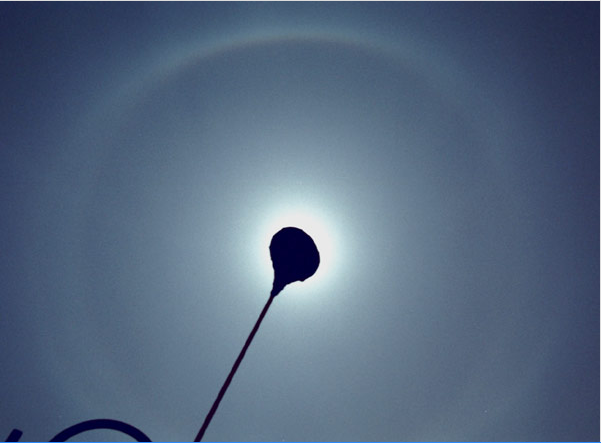Lunar Circumscribed Halo
Lunar Circumscribed Halo: A Rare and Enchanting Sight
When gazing up at the night sky, we are often captivated by the celestial wonders that unfold before our eyes. One such mesmerizing phenomenon is the lunar circumscribed halo. This ethereal display of light occurs when the Moon is encircled by a halo that appears to be tightly wrapped around its circumference. In addition to the circumscribed halo, one can also observe the presence of a 22º halo, and if one looks closely, the faint paraselenic circle curving away on both sides of the Moon. These captivating optical phenomena are a sight to behold, and they offer us a glimpse into the intricate workings of light in our atmosphere.
The lunar circumscribed halo is a relatively rare occurrence, making it all the more enchanting when it graces our night sky. It is formed by the interaction of light with ice crystals present in high-altitude cirrus clouds. These tiny ice crystals act as prisms, bending and refracting the incoming light. As a result, the light is dispersed and separated into its constituent colors, creating a halo around the Moon.
To fully appreciate the beauty of the lunar circumscribed halo, it is essential to understand the science behind its formation. The ice crystals responsible for this phenomenon are typically hexagonal in shape, with their flat faces parallel to the ground. As light passes through these crystals, it undergoes a process known as refraction. The refraction causes the light to change direction and split into its component colors, similar to how light is dispersed when passing through a prism.
The 22º halo that accompanies the circumscribed halo is another stunning feature of this atmospheric optical display. This halo appears as a ring around the Moon at an angle of approximately 22 degrees from its center. It is formed by the refraction and reflection of light within the ice crystals, resulting in a circular band of light.
In addition to the circumscribed and 22º halos, keen observers may notice the presence of the paraselenic circle. This faint circle, similar to the parhelic circle but specific to the Moon, curves away from the lunar disk on both sides. It is caused by sunlight passing through horizontally oriented ice crystals, resulting in a curved band of light that mirrors the shape of the Moon.
The occurrence of a lunar circumscribed halo is dependent on several factors, including the presence of cirrus clouds at high altitudes and the availability of ice crystals within these clouds. These conditions are often prevalent in regions where cold fronts or upper-level disturbances are present. Therefore, the likelihood of witnessing this enchanting phenomenon is heightened during certain weather patterns.
When fortunate enough to witness a lunar circumscribed halo, it is an experience that leaves us in awe of the natural world. The ethereal beauty of this optical display serves as a reminder of the intricate interplay between light and atmospheric conditions. It encourages us to marvel at the wonders that unfold above us and inspires us to delve deeper into the mysteries of our universe.
In conclusion, the lunar circumscribed halo is a rare and captivating sight that offers a glimpse into the mesmerizing world of atmospheric optics. From the tightly wrapped halo encircling the Moon to the accompanying 22º halo and the faint paraselenic circle, each element adds to the enchantment of this celestial display. By understanding the scientific principles behind its formation and the conditions necessary for its occurrence, we can fully appreciate the intricate beauty of this natural phenomenon. So, let us continue to gaze skyward, for who knows what other hidden wonders await our curious eyes.

Circumscribed and 22º halos around the Moon. This rare sight was imaged by William Trost at New Carlisle, Ohio USA on March 17th '03 with the moon almost full . Look carefully to see also the faint paraselenic circle, the lunar counterpart of the parhelic circle, curving away apparently upwards on both sides of the moon.
Note: this article has been automatically converted from the old site and may not appear as intended. You can find the original article here.
Reference Atmospheric Optics
If you use any of the definitions, information, or data presented on Atmospheric Optics, please copy the link or reference below to properly credit us as the reference source. Thank you!
-
<a href="https://atoptics.co.uk/blog/lunar-circumscribed-halo/">Lunar Circumscribed Halo</a>
-
"Lunar Circumscribed Halo". Atmospheric Optics. Accessed on November 16, 2024. https://atoptics.co.uk/blog/lunar-circumscribed-halo/.
-
"Lunar Circumscribed Halo". Atmospheric Optics, https://atoptics.co.uk/blog/lunar-circumscribed-halo/. Accessed 16 November, 2024
-
Lunar Circumscribed Halo. Atmospheric Optics. Retrieved from https://atoptics.co.uk/blog/lunar-circumscribed-halo/.